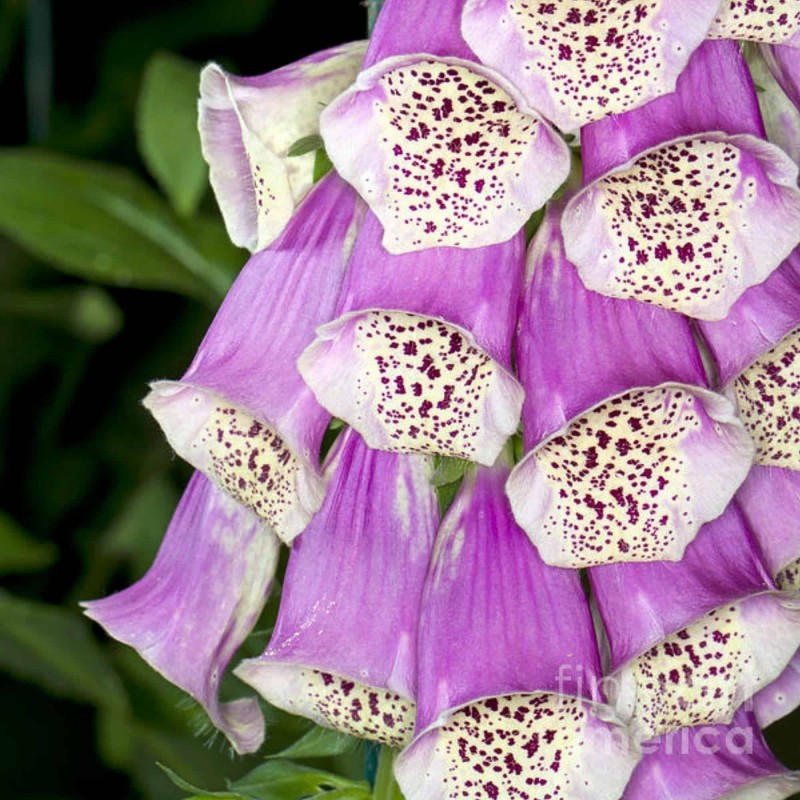Foxglove Excelsior mix Seeds
Price for Package of 100 seeds.
Variety with white, pink, rose and purple flowers, sometimes speckled. Flowering occurs from the bottom to the top of the flower stem. The tubular flowers are visited regularly by bees that completely disappear within the flower in their search for nectar. Prefers the semi-shade. Although a biennial, the plant often continues further if it is cut back soon after flowering.
Soil type Prefers moist, humus-rich soil This is a popular and outstanding strain of Foxglove that produces wonderful, tall dense spikes of blooms in a wide range of colours. Unlike some varieties, the flowers are borne all the way around the stem and are held horizontally, they display the heavily spotted throat markings to better advantage. With a wonderful colour range, they are a most effective and spectacular strain of Foxglove that flowers from late spring throughout summer. They are superb for shady shrub and tree areas, back of borders and excellent for cut flowers. They can really bring the early summer garden alive
Sowing:Sow indoors: March-May or outdoors in May-June or Sept-Oct
Sow seeds on the surface of a peaty soil. Do not cover or bury seeds as the seed needs light to germinate, just press seeds lightly into the earth. Keep seed in constant moisture (not wet) they will usually germinate in 2 to 4 weeks at around 20°C (68°F).
Sowing Indoors: Sow in March to May, 10-12 weeks before last frost. Sow seed thinly in trays of compost and place in a cold frame or greenhouse. Once germination occurs keep in cooler conditions. Prick out each seedling as it becomes large enough to handle, transplant into 7.5cm (3in) pots or trays to grow on. Gradually acclimatise to outdoor conditions for 10-15 days before planting out once all risk of frost has gone. Transplant to the flowering position planting 30cm (12in) apart.
Sow in May to June or September to October directly in a well prepared bed. Sow seed thinly in drills 30cm (12in) apart. Firm down gently. Keep the plants moist and free of weeds. Thin out seedlings to 15cm (6in) apart when large enough to handle.
Cultivation: Foxgloves are biennial which means that plants establish and grow leaves in the first year, they send up large spikes, then flower and seed in the second.
As a rule, they are hardy plants and can cope with any soil unless it is very wet or very dry. They are fairly disease resistant, although the leaves may suffer slightly from powdery mildew if the summer is hot and humid. If you cut the stalk down before it goes to seed, it will generally rebloom through August and, if you wish, you can reseed from the second showing. Self-sown seedlings producing different shifting, untutored patterns of flowers each year, they can be easily transplanted to the location you want them to bloom. They are best transplanted when the leaves are about 10cm long. Make sure the newly moved plants are watered very well to help them establish. Saving seed: Cover the flowerspikes with paper bags (such as those used by bakers to wrap baguettes) to collect the seeds. When the seedheads have dried, shake them to remove the seed and scatter them where you want them to grow.
Caution:
Digitalis is a source of digitalin used in cardiac medicine, it slows the heart. The whole foxglove plant is toxic, no part is edible and if eaten it will cause severe discomfort, in a child or small animal it could cause death. Fortunately it tastes very bitter and causes irritation of the mucous membranes in the mouth, actually causing pain and swelling. It also causes diarrhoea, nausea and vomiting, so if it does get in, it soon comes out! Because of these factors, it is not really a problem for wildlife or humans. However if you ever find a child who has been around this plant with oral irritation, grab a stem or two and get to the emergency room! Wear gloves when handling plants or seeds, plant where children or animals will not have access.
Plant Uses: Shade/Woodland Garden. Cottage/Informal Garden, Cut Flower Arranging, Flowers Borders and Beds, Wildflower Gardens or Wildlife Gardens Other Uses: If foxgloves are grown near most plants they will stimulate growth and help to resist disease and if grown near apples,
potatoes and
tomatoes their storage qualities will he greatly improved. Foxgloves in a flower arrangement make all the other flowers last longer - if you do not want the actual flowers in the vase make some foxglove tea from the stems or blossoms and add to the water.
Flowers: Cream, pink, primrose, maroon
Blooms: in late spring through summer
Foliage: Mid green, hairy lance shaped leaves
Height: 120-150cm (48-60in)
Spread: 45-60cm (18-24in)
Position: Sun or shade.







 Reviews (0)
Reviews (0)